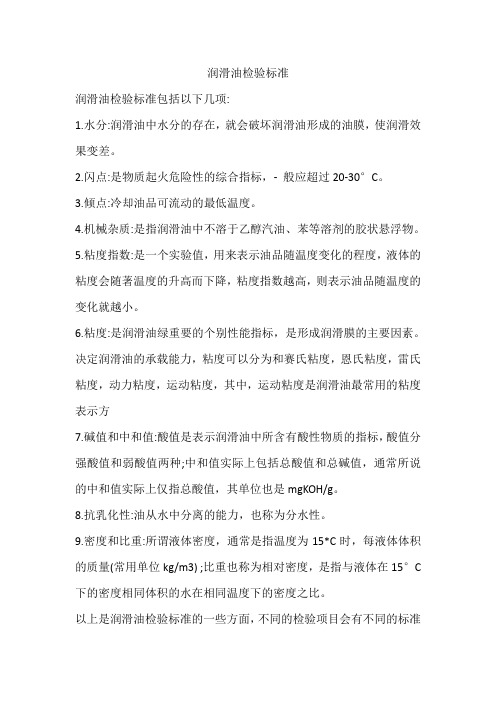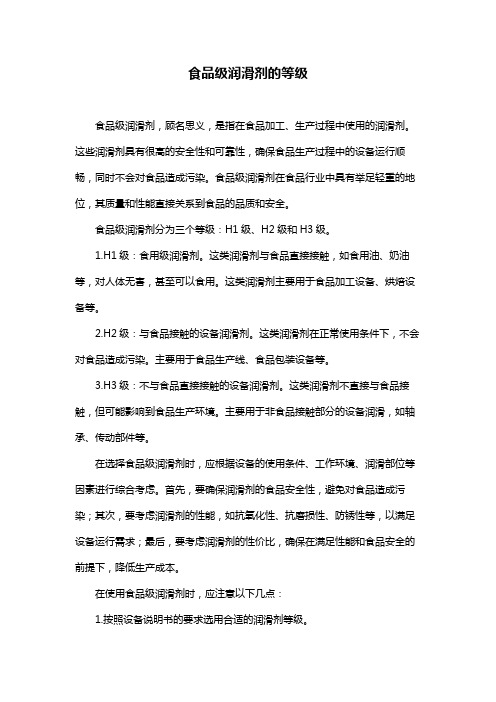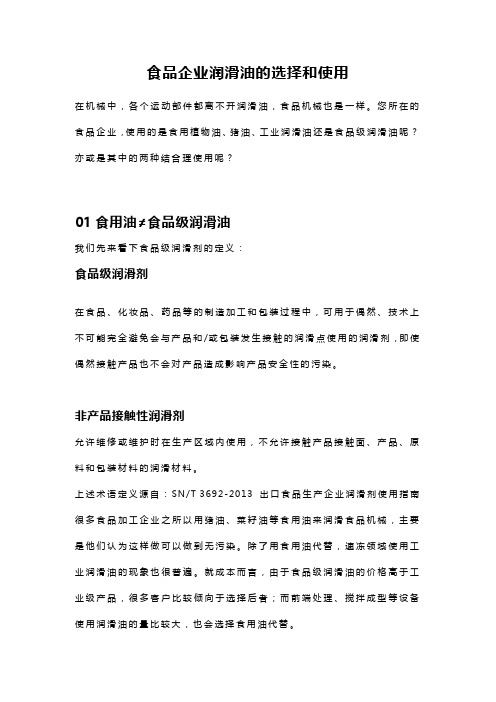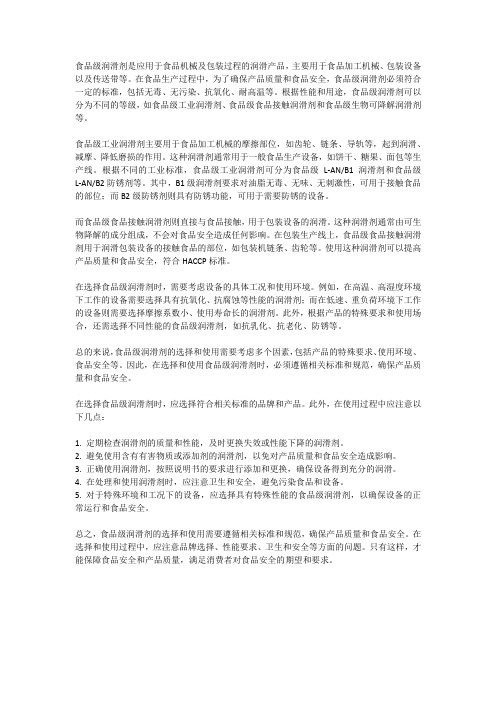食品级润滑油验收标准
润滑油检验标准

润滑油检验标准
润滑油检验标准包括以下几项:
1.水分:润滑油中水分的存在,就会破坏润滑油形成的油膜,使润滑效果变差。
2.闪点:是物质起火危险性的综合指标,- 般应超过20-30°C。
3.倾点:冷却油品可流动的最低温度。
4.机械杂质:是指润滑油中不溶于乙醇汽油、苯等溶剂的胶状悬浮物。
5.粘度指数:是一个实验值,用来表示油品随温度变化的程度,液体的粘度会随著温度的升高而下降,粘度指数越高,则表示油品随温度的变化就越小。
6.粘度:是润滑油绿重要的个别性能指标,是形成润滑膜的主要因素。
决定润滑油的承载能力,粘度可以分为和赛氏粘度,恩氏粘度,雷氏粘度,动力粘度,运动粘度,其中,运动粘度是润滑油最常用的粘度表示方
7.碱值和中和值:酸值是表示润滑油中所含有酸性物质的指标,酸值分强酸值和弱酸值两种;中和值实际上包括总酸值和总碱值,通常所说的中和值实际上仅指总酸值,其单位也是mgKOH/g。
8.抗乳化性:油从水中分离的能力,也称为分水性。
9.密度和比重:所谓液体密度,通常是指温度为15*C时,每液体体积的质量(常用单位kg/m3) ;比重也称为相对密度,是指与液体在15°C 下的密度相同体积的水在相同温度下的密度之比。
以上是润滑油检验标准的一些方面,不同的检验项目会有不同的标准
和测试方法,吴体需要根据实际需要进行选择和执行。
制表:审核:批准:。
食品级润滑剂的等级

食品级润滑剂的等级食品级润滑剂,顾名思义,是指在食品加工、生产过程中使用的润滑剂。
这些润滑剂具有很高的安全性和可靠性,确保食品生产过程中的设备运行顺畅,同时不会对食品造成污染。
食品级润滑剂在食品行业中具有举足轻重的地位,其质量和性能直接关系到食品的品质和安全。
食品级润滑剂分为三个等级:H1级、H2级和H3级。
1.H1级:食用级润滑剂。
这类润滑剂与食品直接接触,如食用油、奶油等,对人体无害,甚至可以食用。
这类润滑剂主要用于食品加工设备、烘焙设备等。
2.H2级:与食品接触的设备润滑剂。
这类润滑剂在正常使用条件下,不会对食品造成污染。
主要用于食品生产线、食品包装设备等。
3.H3级:不与食品直接接触的设备润滑剂。
这类润滑剂不直接与食品接触,但可能影响到食品生产环境。
主要用于非食品接触部分的设备润滑,如轴承、传动部件等。
在选择食品级润滑剂时,应根据设备的使用条件、工作环境、润滑部位等因素进行综合考虑。
首先,要确保润滑剂的食品安全性,避免对食品造成污染;其次,要考虑润滑剂的性能,如抗氧化性、抗磨损性、防锈性等,以满足设备运行需求;最后,要考虑润滑剂的性价比,确保在满足性能和食品安全的前提下,降低生产成本。
在使用食品级润滑剂时,应注意以下几点:1.按照设备说明书的要求选用合适的润滑剂等级。
2.确保润滑部位清洁,避免污染润滑剂。
3.定期检查润滑剂的质量和水平,及时补充或更换。
4.避免润滑剂与食品接触,防止污染食品。
5.妥善保存润滑剂,防止变质、污染。
总之,食品级润滑剂在食品行业中起着至关重要的作用。
正确选择和使用食品级润滑剂,既能确保设备运行顺畅,又能保障食品的安全。
食品级润滑油检测报告

食品级润滑油检测报告1. 摘要本报告针对样品进行了一系列的检测,包括物理性质、化学性质和微生物指标等,以确保其符合国家食品安全标准。
本报告将详细阐述检测结果。
2. 检测样品本次检测的样品为食品级润滑油,样品编号为###,生产日期为###,生产商为###。
3. 检测项目与方法3.1 物理性质3.1.1 颜色和透明度使用标准比色卡进行检测,观察样品颜色和透明度。
3.1.2 粘度使用粘度计按照GB/T 265标准方法进行检测。
3.1.3 闪点使用闭口闪点测定仪按照GB/T 261标准方法进行检测。
3.2 化学性质3.2.1 酸值使用酸值测定仪按照GB/T 444标准方法进行检测。
3.2.2 水分使用水分测定仪按照GB/T 5009.3标准方法进行检测。
3.2.3 皂化值使用皂化值测定仪按照GB/T 3146标准方法进行检测。
3.3 微生物指标3.3.1 细菌总数使用平板计数法按照GB/T 4789.2标准方法进行检测。
3.3.2 霉菌总数使用平板计数法按照GB/T 4789.15标准方法进行检测。
3.3.3 沙门氏菌使用平板计数法按照GB/T 4789.4标准方法进行检测。
4. 检测结果4.1 物理性质4.1.1 颜色和透明度样品呈无色透明液体。
4.1.2 粘度样品粘度符合国家标准。
4.1.3 闪点样品闪点符合国家标准。
4.2 化学性质4.2.1 酸值样品酸值符合国家标准。
4.2.2 水分样品水分符合国家标准。
4.2.3 皂化值样品皂化值符合国家标准。
4.3 微生物指标4.3.1 细菌总数样品细菌总数符合国家标准。
4.3.2 霉菌总数样品霉菌总数符合国家标准。
4.3.3 沙门氏菌样品沙门氏菌检测阴性。
5. 结论根据检测结果,样品符合国家食品安全标准,可放心使用。
6. 建议使用时请按照产品说明书进行,注意密封保存,避免阳光直射。
7. 报告日期本报告于###年##月##日完成。
---以上为食品级润滑油检测报告的模板,具体内容需根据实际检测结果进行修改。
润滑油验收标准

润滑油验收标准
润滑油的验收标准主要包括以下几个方面:
1. 外观:润滑油必须是透明的,无浑浊,无沉淀,无悬浮物。
颜色应该均匀,无变色,无分层,无色差。
2. 液位:油品的液位应该平稳,无漏液,无渗漏。
3. 温度:润滑油的温度应该符合产品规定的范围内,过高或过低的温度会影响润滑油的性能。
4. 毛刺:指油品表面有一些毛状物,一般由悬浮在油中的固体颗粒、纤维、金属屑等引起。
毛刺不能存在于透明度要求的区域内,不能看到紫外线透过毛刺区域发生弯曲。
5. 气泡:指油品中存在的气泡。
明显的气泡应当被均匀分布,大小应为均一且不超过1mm,气泡的数量不能超过2个。
6. 大颗粒:指直径大于10um的固体颗粒。
不能存在于透明度要求的区域内,直径不能大于等于50um。
7. 粘度异物:指润滑油中加入了不一致的石油产品或使用周期过长油品变质导致油品粘度异常。
不能存在于润滑部件内的修改。
这些标准主要是为了确保润滑油的质量和性能,从而保证机械设备的正常运行和延长设备的使用寿命。
此外,不同设备和场合可能需要不同类型的润滑油,因此在选择和使用润滑油时,应充分考虑设备的要求和实际情况。
食品企业润滑油的选择和使用

食品企业润滑油的选择和使用在机械中,各个运动部件都离不开润滑油,食品机械也是一样。
您所在的食品企业,使用的是食用植物油、猪油、工业润滑油还是食品级润滑油呢?亦或是其中的两种结合理使用呢?01食用油≠食品级润滑油我们先来看下食品级润滑剂的定义:食品级润滑剂在食品、化妆品、药品等的制造加工和包装过程中,可用于偶然、技术上不可能完全避免会与产品和/或包装发生接触的润滑点使用的润滑剂,即使偶然接触产品也不会对产品造成影响产品安全性的污染。
非产品接触性润滑剂允许维修或维护时在生产区域内使用,不允许接触产品接触面、产品、原料和包装材料的润滑材料。
上述术语定义源自:SN/T 3692-2013 出口食品生产企业润滑剂使用指南很多食品加工企业之所以用猪油、菜籽油等食用油来润滑食品机械,主要是他们认为这样做可以做到无污染。
除了用食用油代替,速冻领域使用工业润滑油的现象也很普遍。
就成本而言,由于食品级润滑油的价格高于工业级产品,很多客户比较倾向于选择后者;而前端处理、搅拌成型等设备使用润滑油的量比较大,也会选择食用油代替。
可是,食用油并不能替代食品级润滑油。
主要有以下原因:食用油润滑作用很小,而且还容易滋生细菌。
如果真的可以代替,一些加工食用油产品的企业也不会买食品级润滑油来润滑设备了;食用油基本没有润滑性能,而且极易磨损设备,从而增加零部件损耗和维修费用;食用油的抗水性、抗高低温的性能也不好,在高温、高湿环境下很快就会生长细菌、发霉变质,产生有毒有害物质,从而污染食品。
02食品级润滑油的选择就算是食品级润滑油,在食品机械中也不能乱用。
由于食品级润滑油是专门针对食品机械的工作环境来设计配方的,机械设备的生产环境、工况、与食品接触程度的不同,食品级润滑油的产品和解决方案也不同。
主要包括以下三类:几种常用润滑剂的选择食品级液压油的选择,主要应考虑以下三方面:一、液压油的抗氧化性及热稳定性。
液压油的抗氧化性及抗热分解性可使液压系统免受油泥及漆膜的影响,从而保证液压阀门及驱动装置的平滑和可靠运转。
食品级润滑油产品说明

食品级润滑油产品说明
产品简介
本产品是一种食品级润滑油,专门用于食品加工行业中的润滑
和保护。
它具有以下特点:
- 100%食品级原料制成,符合食品安全标准;
- 优异的润滑性能,能有效减少机械设备的摩擦和磨损;
- 耐高温性能良好,适用于高温环境下的使用;
- 不含有害物质,不会对食品质量产生负面影响;
- 具有良好的稳定性和耐久性,使用寿命长。
适用范围
本产品适用于各类食品加工设备的润滑和保护,包括但不限于:
- 食品包装机械;
- 切割、搅拌和混合设备;
- 烘烤、炸炉和烤箱;
- 输送带和链条系统;
- 热封机和灌装设备。
使用方法
在使用本产品前,请仔细阅读以下使用说明:
1. 请确保设备清洁干净,无杂质和污垢;
2. 将本产品均匀涂抹在需要润滑的部位;
3. 根据设备使用情况,定期检查润滑油的使用情况,并进行补
充或更换;
4. 使用过程中如有异常情况,请立即停止使用并咨询专业人士。
注意事项
为了确保使用安全和产品性能,请注意以下事项:
- 本产品仅限于用于食品加工行业中的设备润滑,禁止用于其
他非食品行业;
- 请勿将本产品与其他润滑油混合使用;
- 请存放在阴凉、干燥的地方,避免阳光直射和高温环境;
- 请远离火源和易燃物。
以上为食品级润滑油产品的说明,请按照使用方法和注意事项正确使用本产品,以确保设备的正常运行和食品的安全性。
如有任何疑问,请及时联系我们的客服人员。
食品级润滑剂的等级

食品级润滑剂是应用于食品机械及包装过程的润滑产品,主要用于食品加工机械、包装设备以及传送带等。
在食品生产过程中,为了确保产品质量和食品安全,食品级润滑剂必须符合一定的标准,包括无毒、无污染、抗氧化、耐高温等。
根据性能和用途,食品级润滑剂可以分为不同的等级,如食品级工业润滑剂、食品级食品接触润滑剂和食品级生物可降解润滑剂等。
食品级工业润滑剂主要用于食品加工机械的摩擦部位,如齿轮、链条、导轨等,起到润滑、减摩、降低磨损的作用。
这种润滑剂通常用于一般食品生产设备,如饼干、糖果、面包等生产线。
根据不同的工业标准,食品级工业润滑剂可分为食品级L-AN/B1润滑剂和食品级L-AN/B2防锈剂等。
其中,B1级润滑剂要求对油脂无毒、无味、无刺激性,可用于接触食品的部位;而B2级防锈剂则具有防锈功能,可用于需要防锈的设备。
而食品级食品接触润滑剂则直接与食品接触,用于包装设备的润滑。
这种润滑剂通常由可生物降解的成分组成,不会对食品安全造成任何影响。
在包装生产线上,食品级食品接触润滑剂用于润滑包装设备的接触食品的部位,如包装机链条、齿轮等。
使用这种润滑剂可以提高产品质量和食品安全,符合HACCP标准。
在选择食品级润滑剂时,需要考虑设备的具体工况和使用环境。
例如,在高温、高湿度环境下工作的设备需要选择具有抗氧化、抗腐蚀等性能的润滑剂;而在低速、重负荷环境下工作的设备则需要选择摩擦系数小、使用寿命长的润滑剂。
此外,根据产品的特殊要求和使用场合,还需选择不同性能的食品级润滑剂,如抗乳化、抗老化、防锈等。
总的来说,食品级润滑剂的选择和使用需要考虑多个因素,包括产品的特殊要求、使用环境、食品安全等。
因此,在选择和使用食品级润滑剂时,必须遵循相关标准和规范,确保产品质量和食品安全。
在选择食品级润滑剂时,应选择符合相关标准的品牌和产品。
此外,在使用过程中应注意以下几点:1. 定期检查润滑剂的质量和性能,及时更换失效或性能下降的润滑剂。
21cfr178.3570食品级润滑油标准

21 CFR Ch. I (4–1–05 Edition)§178.3570 §178.3570Lubricants with incidental food contact.Lubricants with incidental food con-tact may be safely used on machinery used for producing, manufacturing, packing, processing, preparing, treat-ing, packaging, transporting, or hold-ing food, subject to the provisions of this section: (a) The lubricants are prepared from one or more of the following sub-stances: (1) Substances generally recognized as safe for use in food. (2) Substances used in accordance with the provisions of a prior sanction or approval. (3) Substances identified in this para-graph (a)(3). Substances LimitationsAluminum stearoyl benzoyl hydroxide .........................................For use only as a thickening agent in mineral oil lubricants at alevel not to exceed 10 pct by weight of the mineral oil.N ,N -Bis(2-ethylhexyl)-ar -methyl-1H -benzotriazole-1- methanamine (CAS Reg. No. 94270–86–7).For use as a copper deactivator at a level not to exceed 0.1percent by weight of the lubricant. BHA.BHT.a -Butyl-omega -hydroxypoly(oxyethylene) poly(oxypropylene) produced by random condensation of a 1:1 mixture byweight of ethylene oxide and propylene oxide with butanol;minimum molecular weight 1,500; Chemical Abstracts Serv-ice Registry No. 9038–95–3.Addition to food not to exceed 10 parts per million. a -Butyl-omega -hydroxypoly(oxypropylene); minimum molecular weight 1,500; Chemical Abstracts Service Registry No.9003–13–8.Do.Castor oil .....................................................................................Do.Castor oil, dehydrated .................................................................Do.Castor oil, partially dehydrated ....................................................Do.Dialkyldimethylammonium aluminum silicate (CAS Reg. No. 68953–58–2), which may contain up to 7 percent by weight 1,6-hexanediol (CAS Reg. No. 629–11–8), where the alkylgroups are derived from hydrogenated tallow fatty acids(C 14-C 18) and where the aluminum silicate is derived frombentonite.For use only as a gelling agent in mineral oil lubricants at a level not to exceed 15 percent by weight of the mineral oil. Dimethylpolysiloxane (viscosity greater than 300 centistokes)...Addition to food not to exceed 1 part per million.Di (n -octyl) phosphite (CAS Reg. No. 1809–14–9).....................For use only as an extreme pressure-antiwear adjuvant at alevel not to exceed 0.5 percent by weight of the lubricant.Disodium decanedioate (CAS Reg. No. 17265–14–4)...............For use only:1. As a corrosion inhibitor or rust preventative in mineral oil-bentonite lubricants at a level not to exceed 2 percent byweight of the grease.2. As a corrosion inhibitor or rust preventative only in greasesat a level not to exceed 2 percent by weight of the grease.Disodium E DTA (CAS Reg. No. 139–33–3)...............................For use only as a chelating agent and sequestrant at a levelnot to exceed 0.06 percent by weight of lubricant at final usedilution.Ethoxylated resin phosphate ester mixture consisting of the fol-lowing compounds: For use only as a surfactant to improve lubricity in lubricating fluids complying with this section at a level not to exceed 5percent by weight of the lubricating fluid.1. Poly(methylene-p-tert -butyl- phenoxy)poly-(oxyethylene)mixture of dihydrogen phosphate and monohydrogenphosphate esters (0 to 40 percent of the mixture). Theresin is formed by condensation of 1 mole of p-tert-butylphenol with 2 to 4 moles of formaldehyde and sub-sequent ethoxylation with 4 to 12 moles of ethyleneoxide;.2. Poly(methylene-p-nonylphenoxy) poly(oxyethylene) mix-ture of dihydrogen phosphate and monohydrogen phos-phate esters (0 to 40 percent of the mixture). The resinis formed by condensation of 1 mole of p-nonylphenolwith 2 to 4 moles of formaldehyde and subsequentethoxylation with 4 to 12 moles of ethylene oxide; and.3. n-Tridecyl alcohol mixture of dihydrogen phosphate andmonohydrogen phosphate esters (40 to 80 percent ofthe mixture; CAS Reg. No. 56831–62–0).Fatty acids derived from animal or vegetable sources, and thehydrogenated forms of such fatty acids.2-(8-Heptadecenyl)-4,5-dihydro-1H -imidazole-1-ethanol (CAS Reg. No. 95–38–5).For use at levels not to exceed 0.5 percent by weight of the lu-bricant.Hexamethylenebis(3,5-di-tert -butyl-4-hydroxyhydrocinnamate) (CAS Reg. No. 35074–77–2).For use as an antioxidant at levels not to exceed 0.5 percent by weight of the lubricant.Food and Drug Administration, HHS §178.3570 Substances Limitationsa -Hydro-omega -hydroxypoly (oxyethylene) poly(oxypropylene) produced by random condensation of mixtures of ethyleneoxide and propylene oxide containing 25 to 75 percent byweight of ethylene oxide; minimum molecular weight 1,500;Chemical Abstracts Service Registry No. 9003–11–6.Addition to food not to exceed 10 parts per million. 12-Hydroxystearic acid.Isopropyl oleate ...........................................................................For use only as an adjuvant (to improve lubricity) in mineral oillubricants.Magnesium ricinoleate .................................................................For use only as an adjuvant in mineral oil lubricants at a levelnot to exceed 10 percent by weight of the mineral oil.Mineral oil ....................................................................................Addition to food not to exceed 10 parts per million.N -Methyl-N-(1-oxo-9- octadecenyl)glycine (CAS Reg. No. 110– 25–8).For use as a corrosion inhibitor at levels not to exceed 0.5 per-cent by weight of the lubricant.N -phenylbenzenamine, reaction products with 2,4,4- trimethylpentene (CAS Reg. No. 68411–46–1).For use only as an antioxidant at levels not to exceed 0.5 per-cent by weight of the lubricant.Petrolatum plying with §178.3700. Addition to food not to exceed 10parts per million.Phenyl-a -and/or phenyl-b -naphthylamine ...................................For use only, singly or in combination, as antioxidant in mineraloil lubricants at a level not to exceed a total of 1 percent byweight of the mineral oil.Phosphoric acid, mono- and dihexyl esters, compounds with tetramethylnonylamines and C 11-14alkylamines.For use only as an adjuvant at levels not to exceed 0.5 per-cent by weight of the lubricant. Phosphoric acid, mono- and diisooctyl esters, reacted with tert - alkyl and (C 12-C 14) primary amines (CAS Reg. No. 68187– 67–7).For use only as a corrosion inhibitor or rust preventative inlubricants at a level not to exceed 0.5 percent by weight of the lubricant.Phosphorothioic acid, O, O, O -triphenyl ester, tert -butyl deriva-tives (CAS Reg. No. 192268–65–8).For use only as an extreme pressure-antiwear adjuvant at a level not to exceed 0.5 percent by weight of the lubricant. Polyurea, having a nitrogen content of 9–14 percent based on the dry polyurea weight, produced by reacting tolylene diisocyanate with tall oil fatty acid (C 16and C 18) amine andethylene diamine in a 2:2:1 molar ratio.For use only as an adjuvant in mineral oil lubricants at a level not to exceed 10 percent by weight of the mineral oil. Polybutene (minimum average molecular weight 80,000)..........Addition to food not to exceed 10 parts per million. Polybutene, hydrogenated; complying with the identity pre-scribed under §178.3740.Do.Polyethylene ................................................................................Do.Polyisobutylene (average molecular weight 35,000–140,000 (Flory)).For use only as a thickening agent in mineral oil lubricants. Sodium nitrite ...............................................................................For use only as a rust preventive in mineral oil lubricants at alevel not to exceed 3 percent by weight of the mineral oil.Tetrakis[methylene(3,5-di-tert -butyl-4-hydroxyhydro- cinnamate)]methane (CAS Reg. No. 6683–19–8).For use only as an antioxidant in lubricants at a level not to ex-ceed 0.5 percent by weight of the lubricant.Thiodiethylenebis (3,5-di-tert -butyl-4-hydroxyhydrocinnamate) (CAS Reg. No. 41484-35-9).For use as an antioxidant at levels not to exceed 0.5 percent by weight of the lubricant.Tri[2(or 4)-C 9-10-branched alkylphenyl]phosphorothioate (CAS Reg. No. 126019–82–7).For use only as an extreme pressure-antiwear adjuvant at lev-els not to exceed 0.5 percent by weight of the lubricant. Triphenyl phosphorothionate (CAS Reg. No. 597–82–0)...........For use as an adjuvant in lubricants herein listed at a level notto exceed 0.5 percent by weight of the lubricant.Tris(2,4-di-tert -butylphenyl)phosphite (CAS Reg. NO. 31570– 04–4).For use only as a stabilizer at levels not to exceed 0.5 percent by weight of the lubricant.Thiodiethylenebis(3,5-di-tert-butyl-4-hydroxy-hydro- cinnamate) (CAS Reg. No. 41484–35–9).For use as an antioxidant at levels not to exceed 0.5 percent by weight of the lubricant.Zinc sulfide ..................................................................................For use at levels not to exceed 10 percent by weight of the lu-bricant.(b) The lubricants are used on food-processing equipment as a protectiveantirust film, as a release agent on gas-kets or seals of tank closures, and as alubricant for machine parts and equip-ment in locations in which there is ex-posure of the lubricated part to food.The amount used is the minimum re-quired to accomplish the desired tech-nical effect on the equipment, and theaddition to food of any constituentidentified in this section does not ex-ceed the limitations prescribed. (c) Any substance employed in the production of the lubricants described in this section that is the subject of a regulation in parts 174, 175, 176, 177, 178 and §179.45 of this chapter conforms with any specification in such regula-tion. [42 FR 14609, Mar. 15, 1977] E DITORIAL N OTE : For F EDERAL R EGISTER ci-tations affecting §178.3570, see the List of CFR Sections Affected, which appears in the Finding Aids section of the printed volumeand on GPO Access.。
- 1、下载文档前请自行甄别文档内容的完整性,平台不提供额外的编辑、内容补充、找答案等附加服务。
- 2、"仅部分预览"的文档,不可在线预览部分如存在完整性等问题,可反馈申请退款(可完整预览的文档不适用该条件!)。
- 3、如文档侵犯您的权益,请联系客服反馈,我们会尽快为您处理(人工客服工作时间:9:00-18:30)。
1、产品外包装是否完整、无破损
查看
2、产品标识是否准确清晰
查看
3、产品是否在保质期内
查看
4、产品颜色是否正常(白色)
查看
5、产品气味是否正常,无不良气味
嗅闻
食品级润滑油验收标准
编制
审核
批准
项目
标准
验收方式
相关证书
1、必须是合格供方名录内的化学品制造商,如不在名录内,应先向采购部提出申请
查看
2、初次供货需提供营业执照、生产许可证、卫生许可证、检测报告等复印件及MSDS
查看
3、每批化学品送货时须附检ห้องสมุดไป่ตู้报告或合格证
查看
运输车辆
1、车厢内是否清洁卫生
查看
2、车厢内是否有影响产品有效性的物品
查看
